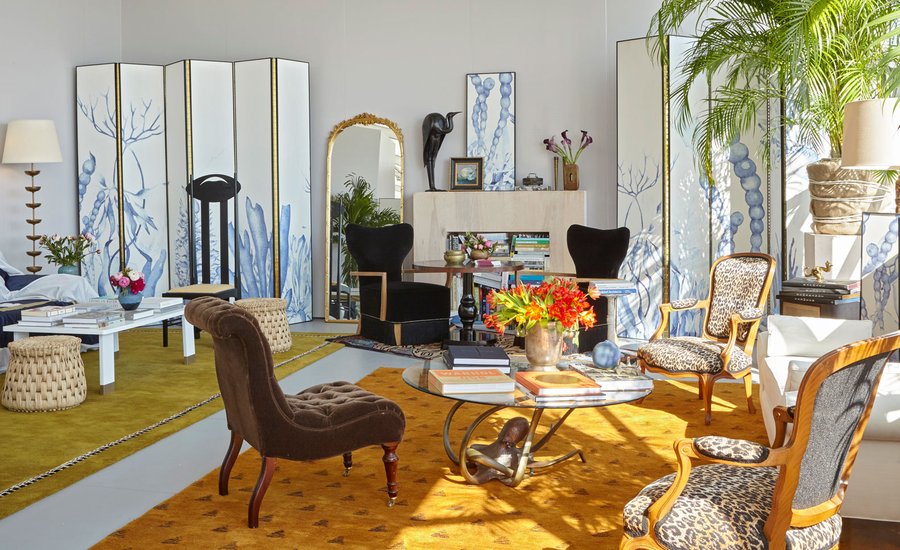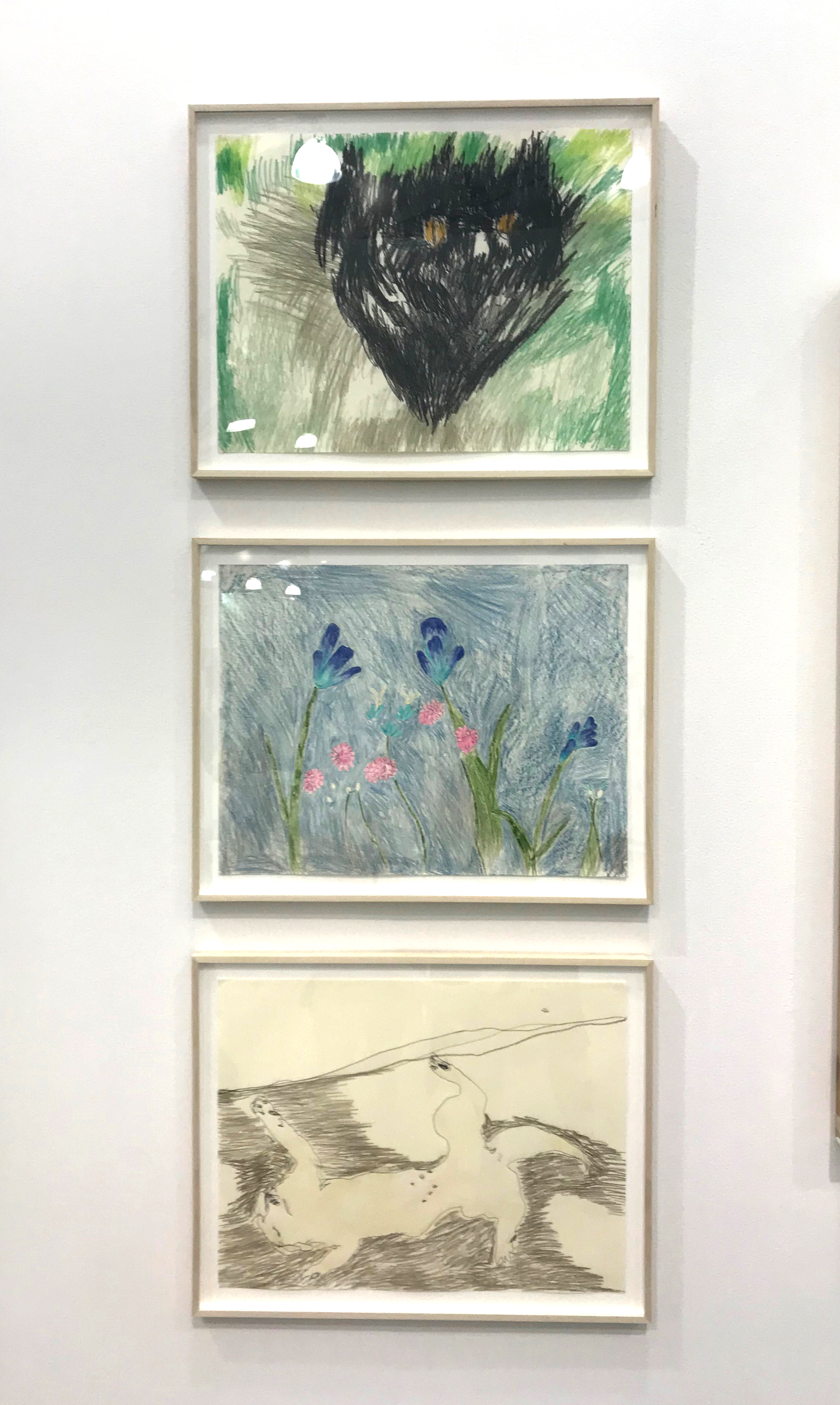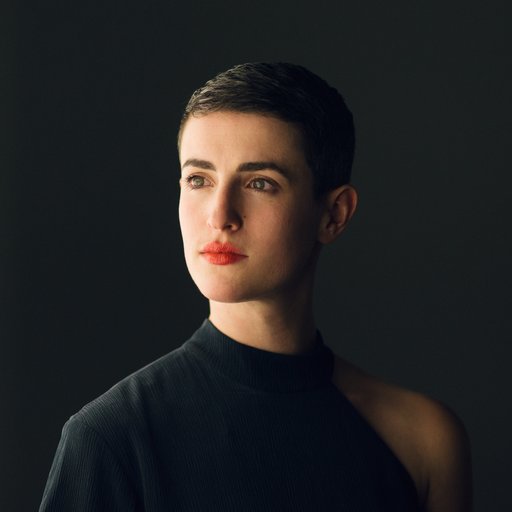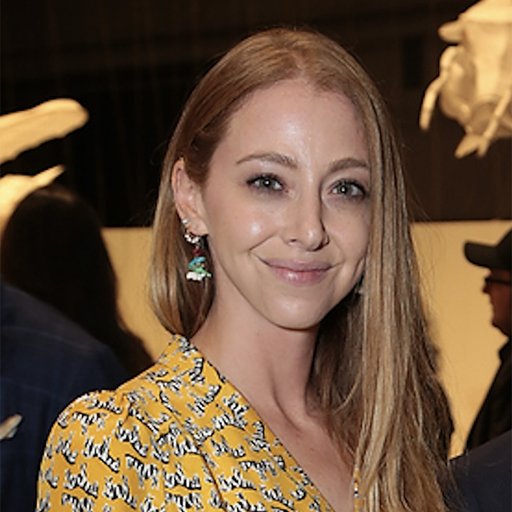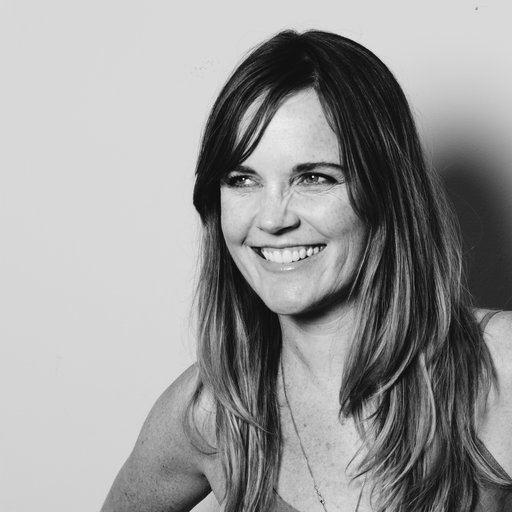Untitled Art, Miami Beach opened to VIPs yesterday at Ocean Drive and 12th Street in South Beach, Miami. Here are six stand-uot works from the fair.
EMILIE GASSIAUX
False Flag
, New York
Booth A24
$1,800 each
In 2010, while Emilie Gassiaux was a student at Cooper Union, she was hit by a car while biking to her summer internship. Ever since, Gassiaux has been black-out blind—making her exuberant drawings and paintings all the more impressive. Following the young artist’s accident, she lay in a coma in the hospital until eventually communicating with her loved ones through touch (she’s also hard of hearing.) Touch continues to be her primary sense, even as a visual artist; using a particular pad of paper that gives easily to pressure, she makes marks that indent the paper, allowing her to feel where she’s drawn. In one particular drawing at False Flag’s booth, we see where the pen failed to deliver ink to the page, yet the evidence of a carved line is visible. “We wouldn’t see this as a line,” says False Flag’s Alex Heffesse, “but to Emilie, this is absolutely a line.”
GORDON CHEUNG
River
, 2018
Edel Assanti
, London
Booth #B20
$30,000 pounds
Gordon Cheung’s large canvases are seductive because of their unusual use of materials (sand, automotive paint, jpeg prints, and clippings from the stock report section of the Financial Times ), but the story they tell reveal Cheung’s approach is much more than just visually motivated. The British Chinese artist represents the expansionist policies of China, and his images are chalk full of symbolism to prove it. Cheung references traditional Chinese landscape paintings, wherein the hight of the depicted mountaintops signify the strength of one’s cultural status, and wherein temples and sacred buildings pepper the landscape. But in Cheung’s version, the religious buildings are replaced by a single “nail house,” a term used to describe homes surrounded by real estate and infrastructure development—so much so that they seem to stick out of the ground like a nail that can’t be hammered down. Entire communities are forced to leave their homes so they can be demolished to make room for these increasingly common development projects, but some people refuse to leave their homes, making their buildings stick out like sore thumbs. To Cheung, the nail house acts as a metaphor for individuality and streangth despite overwhelming pressure and might. In this particular painting depicts the Mekong Delta, which is significant due to the fact that China dammed it’s water source to restrict flow to Cambodia, Thailand, and Laos. Nuanced yet deeply critical of China’s greed, these paintings are worth spending time with.
JONNY NEGRON
A Firm Believer and a Firm Receiver
, 2018
American Medium
, New York
Booth B5
$6,000
One of the few artist-run galleries at Untitled, American Medium has been a crucial component of the emerging art scene in New York since 2012. Initially operating as a roaming gallery hosting shows in various locations in the city, the gallery set up shop in Bed-Stuy, Brooklyn before relocating to Chelsea in Manhattan in 2017. With their ears to the ground and their fingers to the pulse, they always seem to lift up emerging artists, and self-taught Puerto Rican-born artist Jonny Negron is no exception. He’s been likely overlooked by some due to his background as an illustrator and comic artist, “which is a huge mistake,” says American Medium’s Travis Fitzgerald. In the last couple of years the artist has been focusing on figurative paintings that foreground smooth figures atop gradient or abstracted backgrounds. All three of the works on view at Untitled feature fragments of figures that look as if they’re emerging from the corner of a dark room. “They’re like characters at a club that are all related to one another as kin,” the artist tells Artspace. In A Firm Believer and a Firm Receiver , a pair of brothers struggle over a microphone while singing karaoke, according to the artist. Negron, who’s shown in group shows at American Medium, and who had a solo this past July at Chateau Shatto in Los Angeles, is one to watch.
SUMMER WHEAT
Breadwinner with Boiling Water
, 2018
Shulamit Nazarian
, Los Angeles
Booth A8
$17,500
Summer Wheat has become an art fair staple, but unlike some other stalwarts of the commercial circuit, she never sticks to schtick. In other words, just as fast as collectors seem to clamor over her work, she moves onto a different series, technique, or medium—making us always excited to see what she’s whipped up this time around. On view at Shilamlt Nazarian's booth are three paintings that reference art historical representations of masculinity, like hunting and providing. In Wheat’s version, the empowered figures are female. In
Breadwinner with Boiling Water
for instance, a woman is “bring food forth,” says the gallery’s booth attendant. Her technique is unique. By pushing paint through a mesh screen and then using the reverse side as the surface, her textured images feel more like tapestries or textiles than they do canvases.
PACO POMET
After Hours
, 2018
Richard Heller Gallery
, Los Angeles
Booth A41
$10,000 - 15,000
This photograph of After Hours by Paco Pomet does not do the painting justice. In person, the colors are almost otherworldly; rich cool hues radiate from the canvas, extenuated by the bit of warmth in the top left corner, and the moon looks as if it’s phosphorescent. The artist is known for his vivid depictions of dusk and twilight, but this image stands out from his oeuvre with its humor; the moon, the composition’s source of light, is sitting on roof as if stuck, waiting to be rescued by ladder. Pomet was born in Spain, where he currently lives, though he received his MFA from the School of Visual Arts in New York.
WESAAM AL-BADRY
Valentino #X
, 2018
Jenkins Johnson Gallery
, New York and San Francisco
Booth D22
$3,000.00 - $10,000.00
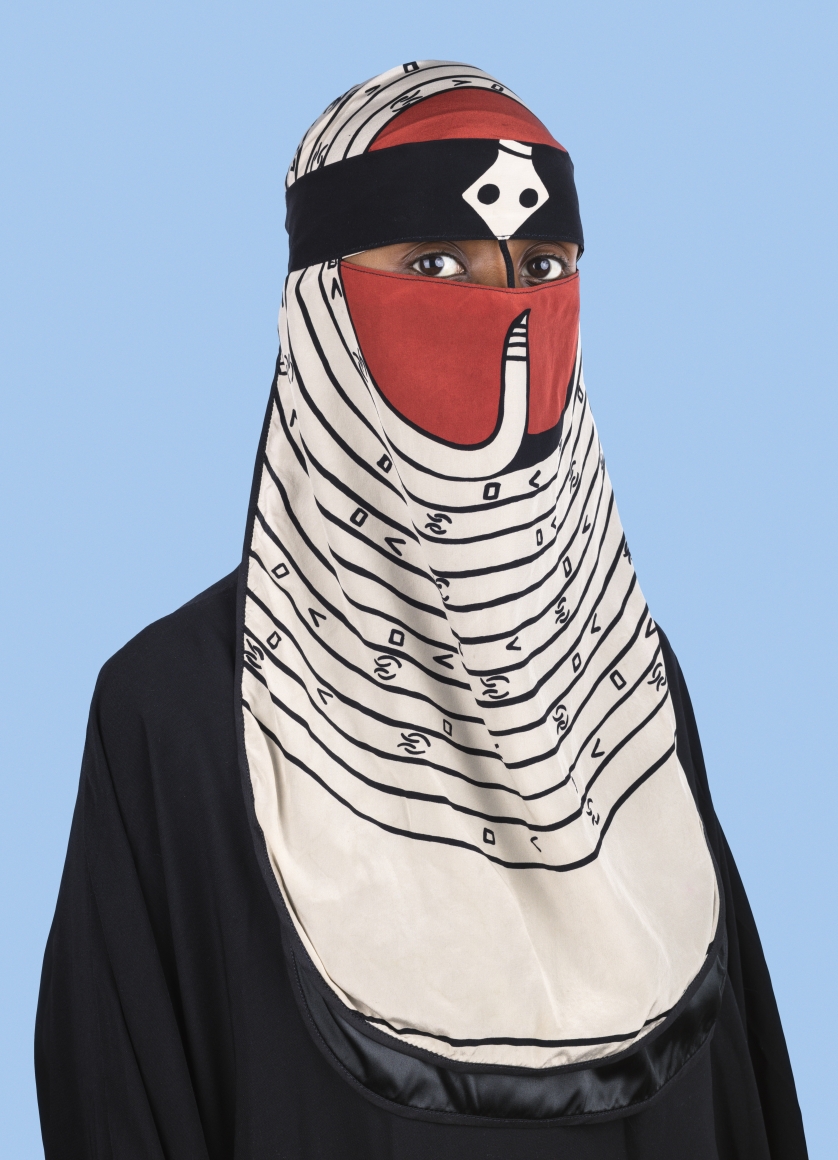
Currently based in San Francisco, Wesaam Al-Badry was born in Nasiriyah, Iraq in 1984. At the age of seven, at the outset of the Gulf War, he, his mother, and his four siblings (including his three-day-old sister) fled on foot, hiking all night until they found refuge at a camp in Saudi Arabia. They remained at the refugee camp for four-and-a-half years, when they relocated to Nebraska. “As a young man growing up in middle America, Al-Badry fiercely felt the disconnect between his experiences in Iraq and the refugee camps and his new American reality,” says the gallery. But now, the relationship between Western ideals and traditional Muslim culture forms the bases of his work. In his artist statement he asks, “Would the Western World accept the niqab if it were on the racks of luxury fashion designers? What happens for the Islamic World by putting seasonal designer patterns/brands on millennia-old cultural traditions?” Al-Badry’s process begins by collecting vintage and contemporary scarves from couture houses like Hermes and Gucci, which he then turns into niqabs, the traditional clothes that some Muslim women wear to cover their faces in public. Staging portraits featuring women wearing these custom luxury niqabs, the artist displays Western consumerism’s influence on Muslim culture, revealing the tension between Occidental and Arab-Islamic ideologies. The artist currently has work at the “Contemporary Muslim Fashion” exhibition at the DeYoung Museum in San Francisco.
RELATED ARTICLES:
New Kids on the Block: 4 Exhibitors at Untitled, Art Miami Beach Worth Checking Out
Untitled Art, Miami Beach Preview: Creative Time's Justine Ludwig Picks Her Favorites











